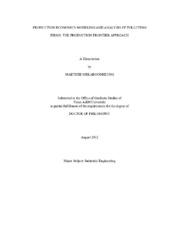| dc.contributor.advisor | Johnson, Andrew L. | |
| dc.creator | Mekaroonreung, Maethee | |
| dc.date.accessioned | 2012-10-19T15:30:44Z | |
| dc.date.accessioned | 2012-10-22T18:02:33Z | |
| dc.date.available | 2014-11-03T19:49:14Z | |
| dc.date.created | 2012-08 | |
| dc.date.issued | 2012-10-19 | |
| dc.date.submitted | August 2012 | |
| dc.identifier.uri | https://hdl.handle.net/1969.1/ETD-TAMU-2012-08-11724 | |
| dc.description.abstract | As concern grows about energy and environment issues, energy and environmental modeling and related policy analysis are critical issues for today's society. Polluting firms such as coal power plants play an important role in providing electricity to drive the U.S. economy as well as producing pollution that damages the environment and human health. This dissertation is intended to model and estimate polluting firms' production using nonparametric methods. First, frontier production function of polluting firms is characterized by weak disposability between outputs and pollutants to reflecting the opportunity cost to reduce pollutants. The StoNED method is extended to estimate a weak disposability frontier production function accounting for random noise in the data. The method is applied to the U.S. coal power plants under the Acid Rain Program to find the average technical inefficiency and shadow price of SO2 and NOx. Second, polluting firms' production processes are modeled characterizing both the output production process and the pollution abatement process. Using the law of conservation of mass applied to the pollution abatement process, this dissertation develops a new frontier pollutant function which then is used to find corresponding marginal abatement cost of pollutants. The StoNEZD method is applied to estimate a frontier pollutant function considering the vintage of capital owned by the polluting firms. The method is applied to estimate the average NOx marginal abatement cost for the U.S. coal power plants under the current Clean Air Interstate Rule NOx program. Last, the effect of a technical change on marginal abatement costs are investigated using an index decomposition technique. The StoNEZD method is extended to estimate sequential frontier pollutant functions reflecting the innovation in pollution reduction. The method is then applied to estimate a technical change effect on a marginal abatement cost of the U.S. coal power plants under the current Clean Air Interstate Rule NOx program. | en |
| dc.format.mimetype | application/pdf | |
| dc.language.iso | en_US | |
| dc.subject | Production economics | en |
| dc.subject | Frontier estimation | en |
| dc.subject | Nonparametric regression | en |
| dc.subject | Shadow pricing | en |
| dc.subject | Marginal abatement cost | en |
| dc.subject | Technical change | en |
| dc.title | Production Economics Modeling and Analysis of Polluting firms: The Production Frontier Approach | en |
| dc.type | Thesis | en |
| thesis.degree.department | Industrial and Systems Engineering | en |
| thesis.degree.discipline | Industrial Engineering | en |
| thesis.degree.grantor | Texas A&M University | en |
| thesis.degree.name | Doctor of Philosophy | en |
| thesis.degree.level | Doctoral | en |
| dc.contributor.committeeMember | Butenko, Sergiy | |
| dc.contributor.committeeMember | Curry, Guy L. | |
| dc.contributor.committeeMember | McCarl, Bruce A. | |
| dc.type.genre | thesis | en |
| dc.type.material | text | en |
| local.embargo.terms | 2014-10-22 | |


